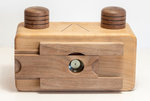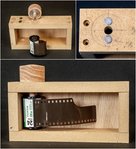Wind: mph,
Welcome to our new web site!
To give our readers a chance to experience all that our new website has to offer, we have made all content freely avaiable, through October 1, 2018.
During this time, print and digital subscribers will not need to log in to view our stories or e-editions.





Editor’s note: Rob Peinert and Dave Brown are both members of the Doña Ana Photography Club. Rob is a collector of old and unusual cameras. When he was interested in adding a wood-bodied pinhole camera to his collection, he contacted Dave, who is also an accomplished woodworker.
One major design problem was how the film would be moved inside the camera.
For such a physically small project it has a lot of precisely made parts. It also required research in optics and resolving problems that at the start did not have clear-cut answers. Through experimentation and prototypes, solutions were found.
One big concern was what to use for the pinhole lens. We needed something more refined and accurate than an aluminum beer can with a hole punched in it. In the end, Rob supplied a pinhole assembly that’s made to be mounted on a Canon digital camera. After attempting non-destructive disassembly with absolutely no luck, a Dremel tool with an abrasive cutoff wheel freed the lens.
With the lens problem along with a film winding and re-winding method resolved, Dave could start on the actual construction. The wood had been narrowed to cherry or walnut, and as aesthetics of the piece were discussed, Rob asked for a contrasting secondary material, so the decision was made to use cherry for the body and walnut for the shutter.
A lot of time was spent in making sure the parts were accurately machined with close tolerances so they can work smoothly together. Even something as simple as cutting a slot in the film-winding shaft where it engages with the web in the film spool required a one-off jig to make two cuts.
The film box is an important piece since a channel cut into it will be where the film rides during the exposure and the edges will cut off the light from getting to the rest of the film.
As the project progressed, edges were softened and sub-assemblies completed. As they were added to the build, it began to look like a camera rather than a collection of parts.
The shutter was the last part. It has only three wood pieces and three rare-earth magnets, but they have to fit together just right to be light tight and work.
The camera’s film boxes (regular and panorama) have a black non-gloss dye applied to prevent any reflection of light hitting the film and fogging the exposure.
Adding a hand-rubbed Danish oil finish on all pieces except the film boxes came last. The oil is used as it is reparable if the camera needs a refresh some years down the road. Applying a three-coat oil finish takes quite a few days but it’s worth it.
Using the camera has been fun but challenging, as using any pinhole camera can be, trying to figure out exposure times. But this is what Rob enjoys about shooting with these simple, unique, “vintage-style” cameras – you don’t know what exactly will turn out, and there is a lot more thinking about the picture-taking process.
This camera is such a unique piece of art to use and manipulate. The way the shutter is opened and closed is so smooth and unlike any other camera Rob has used before; loading and advancing the film – while still a learning process – is so simple using the giant, gorgeous knobs on top.
People see me (Rob) out and ask what I’m using; they too are impressed by the beauty of this camera and the simplicity of how to works. It brings me so much joy while using this camera; I can’t stop smiling because it truly is a piece of art and, literally, a one-of-a-kind camera that I own.
The first roll of film used was a black and white Kodak T-Max 400. While I was familiar with using pinhole cameras, this was a new beast to me. I struggled with loading and advancing the film and trying various exposure times for each frame. I had about six different subjects, but took several photos of each one, with different exposure times. For the first time in a long time, I was taking copious notes on every single frame, documenting exposure times along with the number of turns of the advancement knob.
Getting this roll of film developed also brought an unexpected challenge. The place I’ve used for years in Austin, Texas, had to close for more than a month due to Covid, so it took longer to get results back from that first test roll. I adjusted and went out again and again. Still getting mixed results – again a joy for me when using these types of cameras.
Dave Brown and Rob Peinert, along with other Doña Ana Photography Club members, teach classes in the club’s photography bootcamp, a five-part series aimed at anyone new to photography who has questions about photograph, or wants to take better photographs regardless of the type of camera they use. The bootcamp is currently on hold but will run again later this year or in early 2023.
Visit daphotoclub.org.
Other items that may interest you

